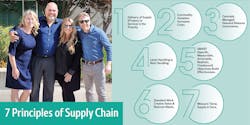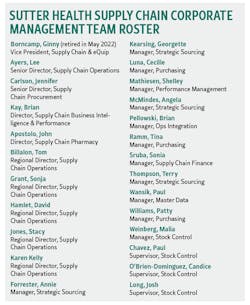Sutter supply chain success stems from back-to-basics modeling
At first glance, in the mindsets of some, success can result from investing in and installing shiny new expensive equipment that taxes the budget, changing group purchasing organizations (GPO) and/or suppliers, outsourcing various operations, playing hardball with product and service contract pricing, or embracing the wonders of information technology.
If you don’t have access to ample financial and labor resources, deep pocket cash reserves or venture capital, success may be more conceptual than reality. And even if you do have access to any of this, success could turn out to be a pipe dream anyway due to a variety of factors—from crises to mismanagement.
But a comprehensive and thorough strategic plan, simply defined and explained, can serve as the great emancipator from inefficiency that ultimately can transform any organization—small or large; urban, suburban, or rural; financially comfortable or perennially and uncomfortably red-lined.
Through thick and thin, leadership changes, pandemic demands and burgeoning operational challenges, northern California-based Sutter Health found value in people to change processes, strategies to improve tactics, partnerships, and professional relationships to generate desired results. The 605-member Supply Chain team of this multifacility integrated delivery network (IDN) relied on internal departmental dedication and expertise, external consulting and services from reliable suppliers and vendors, as well as education and knowledge-sharing from prominent fellow IDNs around the country to fine-tune and hone its own supply chain enterprise.
For these reasons, Healthcare Purchasing News granted Sutter Health the gold chain in being named the 2022 Supply Chain Department of the Year.
Ramping up
In the two years leading up to the COVID-19 pandemic, Sutter’s Supply Chain underwent extensive changes in leadership with three corporate executive updates. Ginny Borncamp, Vice President, who retired three months ago, joined Sutter in 2018. She then brought in Jennifer Carlson, Senior Director, Supply Chain Procurement, to oversee purchasing and sourcing in early 2019, followed by Lee Ayers, Senior Director, Supply Chain Operations, to oversee operations and logistics in late 2019.
“Each of us was selected for our expertise and past performance, and it quickly became clear that we entered a dedicated, hard-working team we could always rely on,” Ayers told HPN. “While our entire team had our work cut out for us, we also had one core belief: Nobody is going to take better care of our organization than the people who are in it. We focused heavily on reducing unneeded contracted support, enriching key external relationships, leveraging internal diversity, and building the Supply Chain brand.”Unbeknownst to them at this point, the onset of the global pandemic was a few months away.
The trio and their team embarked on a three-year plan of infrastructure improvements driven by internally crafting “7 Principles of Supply Chain” (see chart to the right) to guide decision-making throughout all meetings and processes, defining a series of “SMART Key Performance Indicators” (KPIs) to evaluate departmental performance, and developing benchmarking, metrics, and data streams to share progress with sub-departments and key stakeholders.
They derived the SMART concept from a four-decade-old Management Review article published in November 1981 titled, “There’s a S.M.A.R.T. way to write management goals and objectives,” by George Doran, Arthur Miller, and James Cunningham. That trio defined S.M.A.R.T. as “Specific, Measurable, Attainable, Realistic and Timely” and differentiated goals from objectives, proffering that the two concepts were not as interchangeable as many made them out to be.
For Ayers and his colleagues, this philosophy represented a central component of Lean Six Sigma.
“As a Green Belt in this methodology, I had been familiar with this approach for quite some time and thought it would be appropriate during our transformation,” Ayers recounted. “Our system-level executive team and VP of Supply Chain delegated strategy creation to my counterpart (Jen Carlson) and me, but retained approval over the final presentation, which was well-received. They were very excited to see the tangible results, especially when savings was in the double-digit millions and inventory accuracy skyrocketed over 50% across our integrated network.”
What makes the SMART methodology work for healthcare, Sutter’s team in particular?
“The reason SMART goals work is because they create an objective process to measure performance against clear targets,” Ayers noted. “In other words, it enables managers at every level to hold employees accountable for their results and outcomes.”
Of the five letters, two seem to rise above the rest in measurement and achievability, according to Ayers.
“Yes, time frame or time-bound is the ‘T,’” he indicated. “It is simultaneously the easiest to measure and the hardest to achieve because there is no subjectivity to time. Each letter has its importance in the equation, but I would have to say ‘Specific’ is the most important because it defines the scope of the objective. I would also argue it is the most effective because it should never change during the measurement period, unlike other letters in the equation.”
Ayers further believes any other organization can adopt SMART as a strategy and encourages organizations to develop these goals and objectives on an annual basis. But Ayers cautions that while SMART KPIs may be synonymous with SMART goals and objectives, they also extend beyond standard KPIs.
“They are not universal,” he added. “They should be tailored to the culture and objectives of the organization.
The magnificent 7
Believe it or not, the team’s “7 Principles of Supply Chain” finds its roots in the hospitality industry.“I read the book, ‘Excellence Wins,’ written by Horst Schulze, who is the co-founder and former president of the successful hotel chain, Ritz-Carlton,” Ayers recollected. “In this book, he describes a set of principles he created that the teams would cycle through at each of their employee huddles. The concept resonated with me, so we researched the available principles of Supply Chain and then tailored them to fit our department. At every one of our team ‘All Hands,’ [group meetings] we take time to explore the underlying meaning behind one of the principles, cycling through them at least annually.”
Ayers points to “Centrally Managed Demand” (No. 3) as the “easiest” to achieve because it represents “a simple concept to implement.” However, the pandemic reinforced the “hardest” as both “Delivery of Products” (No. 1) and “Commodity Variation” (No. 2) due to the global disruption in the supply chain. “Organizations absolutely should tailor a version of this to their organization,” he added. “It was easy for our leaders to gain buy-in from internal stakeholders to support this.”
To implement this new strategic direction, Supply Chain worked with key partners and stakeholders to establish and solidify the blueprint.
“Internally, we collaborated with Sutter’s Board of Directors, Chief of Clinical Operations, CEO of Sutter Shared Services (S3), Chief Medical Officer, Chief Nursing Officer, Acute and Non-Acute C-suite leaders, physician leaders, service line leaders and many other key stakeholders,” Ayers indicated. “At a high level and externally, we partnered with Vizient (our GPO) and Medline (our primary distributor).”
Ayers promotes Supply Chain’s strategic plan as succinct, simple, and modern, but acknowledges that for other organizations to develop something similar for their own implementation might be a bit challenging, particularly if the executive leadership is looking for quick results and returns.
“In my opinion, it is not particularly hard to implement a strategy such as this, but it may not be an easy task if you have no experience building strategic plans,” Ayers said. “Another barrier may also be that the leadership team needs to agree on the concepts for it to become a reality. Because of these two perspectives, many organizations fail to design and integrate a functional strategy. ROI is certainly an attractive aspect of a strategic plan, especially if it comes with KPIs and other measurements to track progress towards the objectives. The other side of the equation is value. Many of our goals are in the plan because they directly support our core mission and cannot be compromised.”
Taking stock of control
Pressures from the COVID-19 pandemic and the concurrent—if not resulting—global disruptions in access to and availability of products served as an eye-opener to the team, according to Ayers. It motivated them to revamp their supply resiliency strategy as funneled through a distribution control tower model called “Stock Control,” something Ayers parlayed from his prior military experience.
From the beginning of the COVID pandemic, Sutter, and its member facilities dealt with backorders, shrinking product allocations and item discontinuations, he recalled. “Daily lists of aging open orders, POs rejected by distributors due to low allocation and killed logical unit of measure (LUM) requisitions lengthened to alarming proportions,” said David Hamlet, Regional Director, Supply Chain. “Known substitute products became increasingly unavailable as entities around the world grabbed for the same scarce supplies.”
Throughout the lingering pandemic and related supply chain clogs, now in its third year, providers and suppliers frequently have heard the term “resiliency” to the point of exasperation for some. But Ayers and the Sutter Health team gave it more substance as they became “hyper-focused” on product disruption.
“I would define resiliency as a department’s ability to pivot and recover faster than the impact of a challenge or roadblock,” he said. “Having redundant processes, a business continuity plan and a strong professional culture will help sustain resilient operations, where customers and stakeholders never even realized there was a problem to begin with.”Sutter’s Supply Chain resiliency strategy comprised of five progressive steps across each facility and throughout the organization as a whole:
1. Standardize and position emergency supplies
2. Secure and transfer internal/external supplies
3. Access to government agency support
4. Rapidly reassign and acquire resources
5. Return operations to steady state
Under the “Stock Control” model, three elementary functions worked simultaneously: Forecasting represented the proactive via analysts, distributing represented the physical via inventory technicians and purchasing represented the reactive via buyers.
Ayers first saw the term “Stock Control” while he served in the U.S. Air Force.
“[Stock Control] is a corporate Supply Chain office that handles demand planning and order management for the entire organization,” Ayers explained. “I assisted the Air Force to evolve the office from something done at every base to a centralized function. The concept solidified over many decades and resulted in massive cost savings and efficiency, so we modeled our team against the mature structure. Stock Control was approved as our Distribution Control Tower and quickly became our central point for all things disrupted. The team has become a household name, both in our organization and with numerous other health systems under the Vizient umbrella.” Sutter regularly shares its modeling, benchmarked by Vizient, and with other providers during conferences and trade shows.
Ayers likens the Stock Control team to the “Impossible Missions Force” from the “Mission: Impossible” television series and film franchises. The team of 21 includes one manager, three supervisors, nine buyers, six analysts and two inventory techs.
“Stock Control’s scope is anything that comes through distribution and anything that is in our perpetual inventory (storerooms),” he said. “They are a very distinct ‘Impossible Mission Force.’ The team is worth its weight in gold amidst global product disruption and is truly the reason we have sustained product delivery. The Stock Control Manager title is in theory and legend only—the real title is generically labeled ‘Manager, Supply Chain.’ Due to strong logistical focus and direct inventory management, the role reports directly to me.”
Sutter’s Supply Chain Decision Support (SCDS) team created an online two-way communication tool or “Stock Control Portal” that establishes visibility for requestors in the field and enables them to highlight priority open orders and rejections for quicker resolution, according to Ayers. The team populates the portal daily with the latest PO status, refreshed hourly so the Stock Control team can prioritize the incoming requests, and end-of-day comments automatically are transmitted back to the Requestors. They also instituted an “Urgent Request” process and have a buyer, an analyst and couriers standing by to address situations where cases are in jeopardy of being canceled or patient care may be impacted.
“The order management portal arose from a need to effectively communicate and provide visibility to order exceptions in the face of growing backorders and rejections from product disruption,” said Malia Weinberg, Manager, Stock Control. “By allowing the sites to prioritize their most critical needs, Stock Control can focus on the most impactful items needed for patient care.”
SCDS leveraged a PHP website for data visualization, IBM Cognos for data modeling and Informatica Power Center for data integration, according to Weinberg. They synchronized data points between Sutter’s enterprise resource planning system (Infor/Lawson) and daily backorder/killed order/rejection reporting from its primary distributor (Medline) as well as comments from front-line Supply Chain and Stock Control team members. Linking the ERP data with distributor data, such as stock on hand and system-approved substitutions, creates actional data at the user’s fingertips, she notes.The system provides the ability to solve complex or widespread problems within geographically separated teams, making it simple to spot disruption patterns and spread acceptable substitutions or workarounds quickly, according to Ayers.
Stock Control at first wasn’t so tech-enabled, Weinberg recalls.
“Stock Control was initially communicating with spreadsheets, sent daily to Supply Chain site leadership who in turn responded with their requested action,” she said. “Stock Control used that back-and-forth experience to identify the kinds of requests the portal needed to accomplish and automate the communication in an hourly blast to the buying team. Leveraging focus groups and pilot populations, the team honed the look and feel of the portal, such as adding filters to classify orders and ease navigation.”
They continue to tweak the tech. “Stock Control is still enhancing the portal to further integrate with operations and expand to other purchasing groups for our direct purchases,” Weinberg indicated. “Currently, the portal is primarily used by Supply Chain, but Stock Control plans on launching automated requestor emails shortly to provide nearly real-time PO status. These emails will notify all requestors if there is a problem with their order and direct them to the portal to request resolution.”
The results to date? The Stock Control team has maintained on average 2-3 open days per PO, indicative of a “smooth level of service,” according to Ayers. To date, Sutter has not stocked out of medical supplies during the pandemic either, he adds.
Even as this award-winning model gains in promotion and publicity, it’s also primed for emulation, according to Weinberg.
“The Stock Control team model would work for any size organization as the principles of communication, prioritization and a centralized approach to product disruption consistently serve patient care needs,” she said. “All organizations need to identify critical supplies, understand what can be done through distribution channels but also be able to bring in product in house to support the system. The team structure naturally links the proactive function (protecting against future stockouts) with the reactive function (resolving current stockouts). These are two sides of the same coin, and when working together, [they] address product disruption in unique and powerful ways.”Buckling down
Like other healthcare providers around the country, Sutter had to cancel elective surgeries during the pandemic, reinforce the protection of critical patients and slow or prevent the spread of COVID-19 within its facilities. Reduced revenue streams, coupled with increasing expenses from dealing with multiple surges, motivated them to evaluate and pursue financial viability last year. Sutter worked with Vizient on price indexing and “aggressive contract negotiation” as well as a comprehensive stewardship strategy that generated savings for many physician preference items (PPI).
“Sutter had been experiencing significant year-over-year expense increases without revenue offsets, and it had become challenging for the organization,” said Jennifer Carlson, Senior Director, Supply Chain Procurement. “Additionally, our benchmark data indicated we were overpaying for medical devices. We enlisted support from clinical and operations leaders at Sutter to create a new approach that included physicians in the contracting process at the system level. It was not as challenging as you might think to get cooperation from clinicians.
“Most physicians we recruited to participate in stewardship initiatives generally supported the idea of standardizing supplies and reducing complexity in the procedural areas. We offered up several scenarios with different cost models and had them evaluate with a group of their peers. In many PPI projects, such as GI, trocars and endo-mechanicals, physicians opted for highly committed contracts that could bring the best financial value. In other implant categories, they opted for multi-vendor awards that reduced variation but still allowed for some choice.” In fact, they were able to capture more than $60 million in cost savings in 2021 across several PPI categories.
Supply Chain also worked closely with the executive team. “Before launching any of these initiatives, we made sure the executive leaders knew about the projects and that we would need their help to implement them at the local site level. We developed compliance dashboards and started monthly executive leader meetings to review challenges and savings that were generated from the projects. The executive leaders support has been instrumental in the success of the stewardship initiatives,” she said.
The great convergence
Supply Chain transitioned a host of functions and processes from the site level to the system level in 2021, including purchasing, stewardship, technology assessment, demand planning, distribution, and overall compliance measurement to enhance customer service and demonstrate outcomes to leaders.
One prominent example involves the consolidation of local technology assessment committees into a system-level Clinical Technology Assessment Council (CTAC) that pair senior clinical leaders with Supply Chain to discuss and evaluate physician requests for technology throughout the IDN.
Supply Chain also centralized inventory and distribution operations under a tiered approach that centered on maintaining relationships with site-based Supply Chain leaders, Sutter’s prime distributor (Medline) and a host of prime manufacturers, while adding a small warehouse to store PPE and critical supplies, according to Ayers.
The Supply Chain team created internal distribution metrics to increase confidence in product availability, right-size inventory and maximize hand-held technology, Ayers indicated. Web-based Tableau reports were used, enabling team members to extract necessary data to improve the direction of the KPIs, he added.
Supply Chain also worked with Medline to develop a performance dashboard to record and showcase contract compliance and provide talking points for recurring quarterly business reviews, Ayers said.
“In the past, we had an adequate relationship with Medline leaders, but we lacked strategy,” he recalled. “To improve, we quickly developed monthly operational meetings, began tracking contract KPIs, built the first-ever dashboard and scheduled quarterly business reviews. The new professional environment significantly grew our relationship and commitment, leading to an extension of our long-term partnership. Because of COVID’s labor shortages, we hit some challenges in 2021 for ops and logistics, resulting in a sizeable investment from Medline to establish a distribution center dedicated to Sutter.”
Supply Chain shared this intelligence during recurring “Affordability” meetings with site-based leadership teams to highlight distribution and operational metrics, compliance targets, realized and missed savings (the latter to provide incentives to stay contract compliant). This represented a Supply Chain report card for internal customers, which includes executive staff, physicians, clinical directors, and nursing leaders.
Much of this is an outgrowth of Sutter’s 2013 consolidation efforts when the IDN centralized its business support services, including the contact centers, document management, finance, human resources, credentialing verification, revenue cycle, supply chain under one umbrella called Sutter Shared Services (S3).
“Today, the teams within S3 deliver cost-effective, standardized and high-quality services for patients, physicians, hospitals and medical foundations,” Ayers insisted. “As with most evolutions, it requires years, if not decades, for entities to fully mature and start to resemble a universal culture. In 2019, our Supply Chain operations was still a group of facilities, operating mostly independent from one another. Two years later, we solidified standard work, implemented standard huddle boards, expanded SMART KPIs, assigned system performance targets and completed a reorg at the Regional Director level. These seemingly simple achievements paved the way for our department to start acting in harmony and in unison as a system for the first time.”








